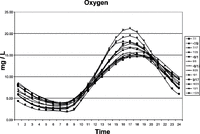Hi all,
but with a lot of surface area and surface water movement my gut thinks that both o2 and co2 should be pretty stable around whatever their natural dissolved concentrations are.
I think you are probably on the money, unfortunately we can't really measure any of the parameters without some pretty expensive kit, so we have to use pH, fish behaviour and plant growth as an indicator.
There has been a lot of work in commercial aquaculture on DO/CO2, but CO2 is only really of interest at high levels, so as long as systems out-gas it fairly efficiently you don't need to know the levels. The basic equation is that; when you add oxygen, either directly or indirectly, you also remove CO2.
But in warmer weather when the temps go up I have to keep that way as I had issues in another tank last summer with lesser surface movement, some sudden deaths when the temps of the tank hit 29-30 C(fish just fell dead in front of my eyes) where I run this tank like a washing machine as it's deep(65cm+) and all fish were perfectly fine, but it isn't helping the plants to be honest as that's the only tank I have algae in. I have good surface movement in other tanks but not quite as much.
This is why a lot of fish death, related to low dissolved oxygen levels, happen at night during thundery weather in the summer, it really is the "perfect storm". Warm water can hold less dissolved oxygen (same for all gases), and low atmospheric pressure also reduces the solubility of gases, if you don't increase the active gas exchange surface then you have the "double whammy" and dead fish.
And the tank is on and off sufferer of BBA
I think probably all low tech tanks get a bit of BBA, I have Red Ramshorn snails that browse it from hard surfaces, but I get it growing on filter sponges etc.
Some aquaculture bits
Because most (all?) commercial fish species don't require soft water, water management is easier in carbonate buffered systems, here are a couple of papers with an introduction to aquaculture: <
https://srac.tamu.edu/index.cfm/event/getFactSheet/whichfactsheet/112/> & <
https://srac.tamu.edu/index.cfm/event/getFactSheet/whichfactsheet/205/>.
There is a lot of work on more efficient aquaculture systems. This is from Brune, D.
et al. (2003)
Aquacultural Engineering 28:1, pp. 65:86 "Intensification of pond aquaculture and high rate photosynthetic systems". I'm not sure whether there is open access (I'm at work), but it is a very interesting paper, and I can email a pdf: <
ScienceDirect.com - Aquacultural Engineering - Intensification of pond aquaculture and high rate photosynthetic systems>. More open access stuff here: <
BruneDavidAlgalSystem>

The paper looks at using partitioning of fish and plants ("green water" algae) and using solar driven paddle wheels for aeration
low energy paddlewheel mixed ponds .... are capable of sustained algal yields of 10–12 g C/m2-day. This three to fourfold increase in algal photosynthesis provides the potential for a similar increase in the rate of pond water detoxification (ammonia removal) while simultaneously providing a solar driven oxygen production system. By superimposing a water velocity field upon the pond it becomes possible to utilize velocity and hydraulic detention time as a controlling strategy in reconfiguring the aquatic ecosystems of pond aquaculture into a series of engineered aquatic processes. High rate photosynthetic systems offer the greatest potential for intensification of pond aquaculture
cheers Darrel




